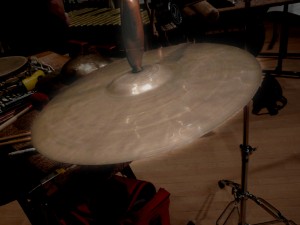 Bob Becker presents a great lecture-demo called The Magic and Mystery of Cymbals. In it he explores history, terminology, special effects and techniques, choices of instrument, and even performance issues such as “misleading notation.” Bob has written a useful article (read it here) that gives a good overview of this fascinating clinic and his thoughts on cymbals and cymbal performance. A non-percussionist such as myself might be forgiven for thinking a cymbal is just a cymbal. Not so! It turns out that it is a unique and amazingly varied instrument with a quirky history.
Bob Becker presents a great lecture-demo called The Magic and Mystery of Cymbals. In it he explores history, terminology, special effects and techniques, choices of instrument, and even performance issues such as “misleading notation.” Bob has written a useful article (read it here) that gives a good overview of this fascinating clinic and his thoughts on cymbals and cymbal performance. A non-percussionist such as myself might be forgiven for thinking a cymbal is just a cymbal. Not so! It turns out that it is a unique and amazingly varied instrument with a quirky history.
The bronze cymbal dates back about 3000 years ago to ancient China. For today’s percussionist there is a vast array of cymbals to choose from. Bob discusses the history of the modern Turkish cymbal. He can fill in the details, (again, check out that article!) but here are a few tidbits of cymbal history: The K Zildjian Company stemmed from a metalsmith named Kerope who became Chief Cauldron Maker for the Ottoman Empire. Kerope’s son developed the famously secret “family recipe” for making cymbals. In Europe, family foundries that made the high quality bells for the great cathedrals also made orchestral cymbals. Moving up to our modern era, apparently the advent of the Beatles caused a gigantic upsurge in cymbal demand and this led to mostly machine-made cymbals being available. Thus, at the end of 2007, the auction price on a classic 20″ K. Zildjian cymbal, hand made in Turkey, could fetch upwards of $2000 or more. But today there is a renaissance in hand made cymbals, and Turkish companies again dominate.
Cymbal terms are anything but straight forward! Some terms mean different things depending on whether you are talking classical orchestral, jazz, pop, or rock’n’roll. After a look at etymology, Bob goes on to demonstrate basic types of crashes, special effects and techniques. He also discusses the fine art of selecting and combining cymbals. When choosing a cymbal you have to think about the context it will be played in, the other instrumentation, one’s playing style (and ability), venue, type of sticks, the versatility and projection of the instrument, its size, bell shape, profile, weight and the hammering/lathing techniques used to make it! One percussionist commented that cymbals are like snowflakes, no two are alike! There are even specialty cymbals such as the cymbals with large holes in them for a “trashy” sound. These include the Sabian Ozone and the Zildjian Trashformer.
In Bob’s discussion and demo he uses excerpts from the symphonic and contemporary repertoire, and approaches performance issues including ambiguous or misleading notation, dynamics and instructions. He finishes with a thoughtful consideration of creative interpretation and imagination, and how these concepts can transform problems into opportunities for a musician’s personal expression. It can be argued that for the young percussionist, this message is the most valuable of all.
You can listen to the many different types and sounds of cymbals online by visiting the Sabian and the Zildjian websites.
